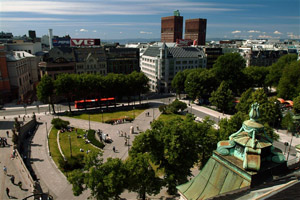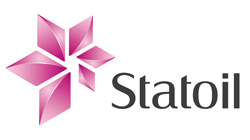16 February 2010
Oslo, Norway
 View over the city. Photo copyrjosirt : VisitOSLO/Nancy Bundt
View over the city. Photo copyrjosirt : VisitOSLO/Nancy Bundt
Organised by

Hosted by
Gassnova SF
Sponsored by


Co-Ordinators:
Dr. Mohammad Abu Zahra, IEA GHG
Erik Gjernes, Gassnova SF
Background:
Amine based post combustion CO2 capture is considered to be the most mature of the capture technologies available today. Capture plants with a capacity of up 300,000 tonnes of CO2 per year have already been constructed and there are established suppliers.
The technology is based on washing the flue gas with a solvent that captures CO2. Thus, a small fraction of this solvent will be released through the stack together with the cleaned flue gas. For a 400 MWe CCGT plant a solvent slip of 1 ppm in the flue gas will add up to about 40 tonnes per year. This release may have a negative environmental impact both directly and indirectly through subsequent solvent degradation into other substances in the atmosphere.
The expected emissions of amines, additives and their degradation products with flue gas stream and waste product streams is a continued concern for the deployment of full scale CO2 post combustion capture using amines.
The major challenges are to quantify the amount and composition of solvent and degradation products in the cleaned flue gas, to understand the atmospheric fate and degradation of these substances and to assess the final impact on the environment. Additional important topics are technical solutions for reducing the level of solvent and degradation products in the cleaned flue gas.
There is a clear lack of understanding in the characteristics of the used solvents and their degradation products. From a global perpective, it is clear that the activities in relation to this topic are limited and there is a clear need for co-operation and knowledge exchange between the different parties doing research in this particular field.
The "Environmental Impact of Amine Emission during Post Combustion Capture" workshop is organized , primarily to share information on the environmental effect of using chemical solvents for the capture of CO2, from conventional combustion based fossil fuel fired power stations.
Objectives
Considering the above mentioned motivation, a workshop with the following objectives will be organised:
- To give an overview of the current on-going environmental impact activities
- A starting point to define gaps of knowledge and R&D areas of interest
- An opportunity for the different active groups to meet and to discuss the related environmental issues
- To build the basis for a future detailed IEAGHG study on environmental impact of post combustion capture. This may be the first activity for follow up workshops or symposiums.
The First Meeting
The first workshop is organised by the IEA Greenhouse Gas R&D Programme in partnership with Gassnova SF, Norway. The objective is to bring together researchers and industry involved in post combustion capture of carbon dioxide to discuss the expected environmental impact of large scale deployment of this technology, the current ongoing activities in relation to this topic and to share knowledge, experience and future plans.
Gassnova SF is the Norwegian state enterprise for carbon capture and storage. The objective of Gassnova SF is to manage governmental interests in CCS. This includes the Norwegian CCS projects at Mongstad and Kårstø as well as supporting technology development through the CLIMIT R&D&D subsidy programme. For more information see: www.gassnova.no.
Agenda
Monday 15th February |
|
|
08.30 Registration and Coffee |
|
|
09.00 to 09.25 |
Welcome and Introduction 0.4MB: Mohammad Abuzahra/Klaus Schöffel, IEAGHG/Gassnova SF |
|
09.25 to 09.50 |
Amines to air - Problem Description 1.1MB: Svein Knudsen, NILU |
|
09.50 to 10.15 |
Flue Gas Degradation of amines 0.8MB: Steinar Pedersen, Statoil |
|
10.15 to 10.40 |
Environmental Impacts of Emissions from Post combustion CO2 Capture 3.4MB: Moetaz Attalla and Merched Azzi, CSIRO |
|
10.40 to 11.00 Coffee Break |
|
| 11.00 to 11.25 | Atmospheric Chemistry of Amines 1.6MB: A Critical Element of EPRI's Research on the Environmental Impacts of Future Electric Sector Emissions: Eladio Knipping, EPRI |
| 11.25 to 11.50 | ADA: Gas Phase Photo-oxidation of 2-Aminoethanol (MEA): Claus Nielsen, University of Oslo |
|
11.50 to 12.15 |
Emission Measurements at Dong’s Pilot Plant for CO2 Capture in Esbjerg - EU Project CESAR 0.6MB: Eirik da Silva (SINTEF), CESAR |
|
12.15 to 13.15 Lunch |
|
| 13.15 to 13.40 | Information Requirements for the Environmental Iimpact Assessment (EIA) Process 0.5MB: Fredrik Weidemann, Norwegian Pollution Control Authority (SFT) |
| 13.40 to 14.05 | Environmental Impacts of Post-Combustion Capture 0.5MB: Case study of SaskPower's Boundary Dam Power Station, Saskatchewan, Canada: Anastassia Manuilova, University of Regina |
| 14.05 to 14.25 | Comparison of Emission Profile Between Conventional Amine and Amino Acid Based Systems 1MB: Henk Trap, TNO |
| 14.25 to 14.45 | MHI Amine Emission Control Technology1MB: Takashi Kamijo, Mitsubishi Heavy Industries |
|
14.45 to 15.00 Coffee Break |
|
|
15.00 to 15.20 |
Econamine FG+ Process: Recent Advances in Emissions Control 0.2MB: Satish Reddy, Fluor |
|
15.20 to 15.40 |
Emission measurement and analysis from Mobile Carbon Capture Test Facility 3MB: Oscar Fr. Graff, Aker Clean Carbon |
|
15.40 to 16.00 |
Workshop discussion and closing: Mohammad Abuzahra/Klaus Schöffel, IEAGHG/Gassnova SF |
|
Close |
|
Contact Details:
Those wishing to receive more information about the workshop or to check the possibility of presenting work at the meeting, please contact Dr. Mohammad Abu Zahra, co-ordinator from IEAGHG This email address is being protected from spambots. You need JavaScript enabled to view it. or Erik Gjernes from Gassnova This email address is being protected from spambots. You need JavaScript enabled to view it..
Queries regarding registration should be made to Andrea Lacey (This email address is being protected from spambots. You need JavaScript enabled to view it.)